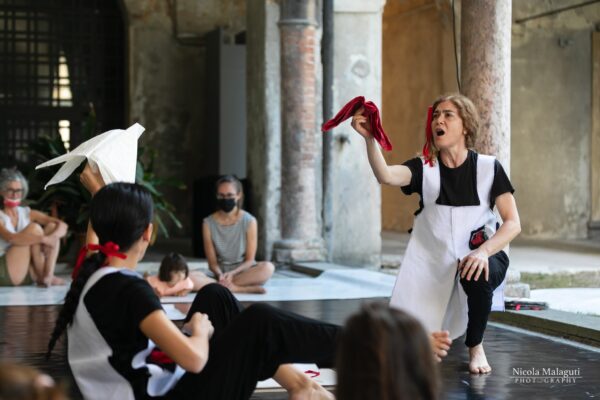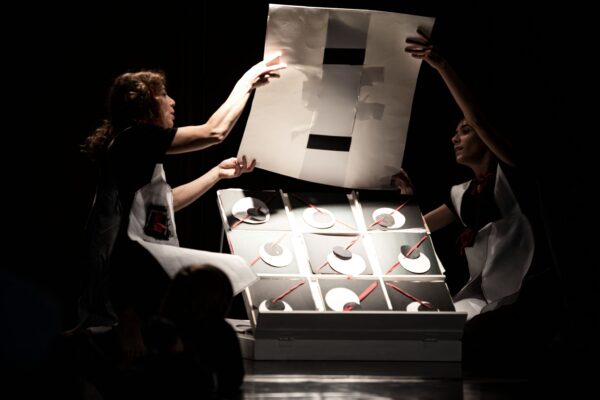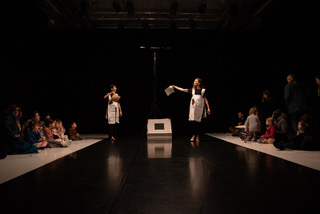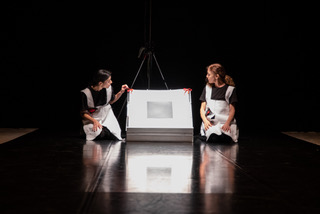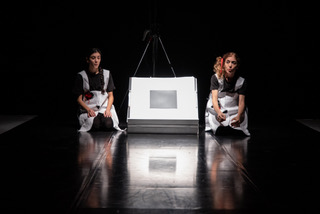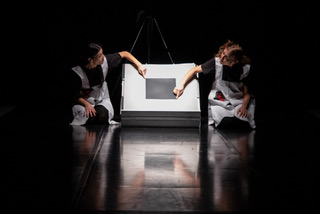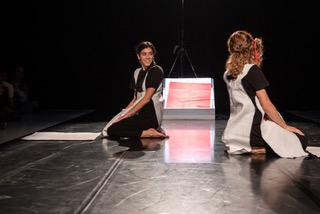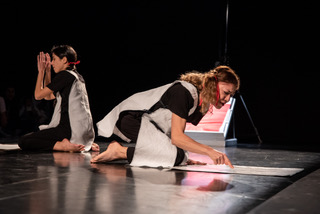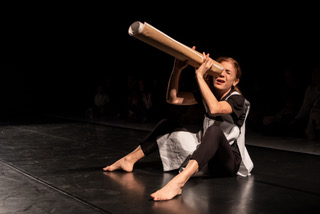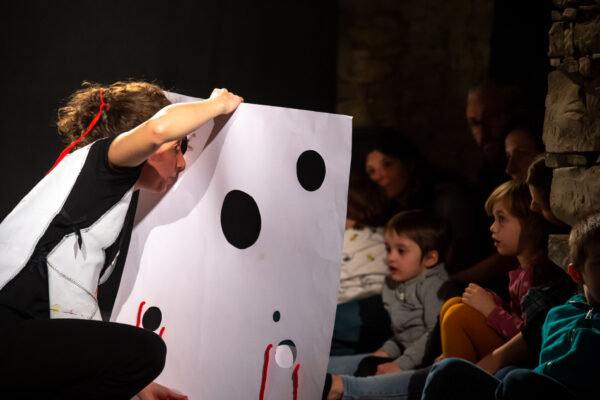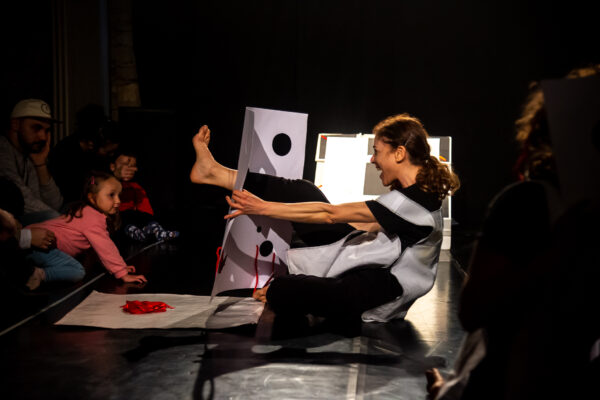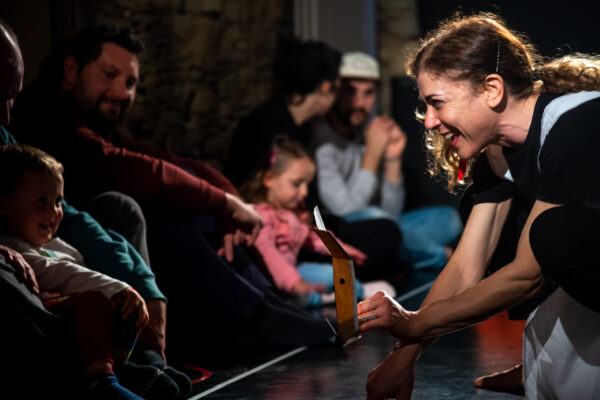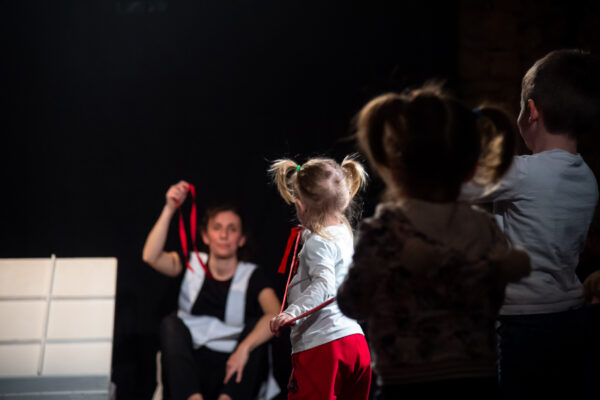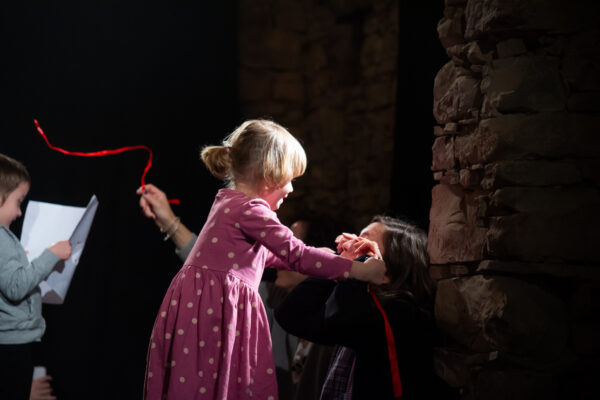Corpo lib(e)ro is a hands-on theatrical performance for children and their parents. At the centre of it all is a great square book made of different kinds of pages: some are marked, other folded, and still more pierced. Infinite possibilities which will be explored through dance, sound and touch open up before the spectators.
The sound of a singing bowl attracts the attention of the young spectators and their parents. A red thread leads all of therm to the spaces on the ground where they are to sit. In the centre of the performance area there is a large square book, somewhat like Bruno Munari’s famous Prelibri or the elegant pages of Katsumi Komagata. As the two dancers begin to move, the wordless performance slowly comes to life. As they dance they play with tissue paper, black card, wrapping paper, threads and red ribbons forming square or round shapes. Their bodies transform the pages, some of them white, some with holes, others folded, yet more light and soft, or marked with a thread or a black circle, and through them the mind’s eye is opened to new vistas. The two dancers use their bodies to read this fantastic book, while their relationship is underscored by a fascinating choreography.
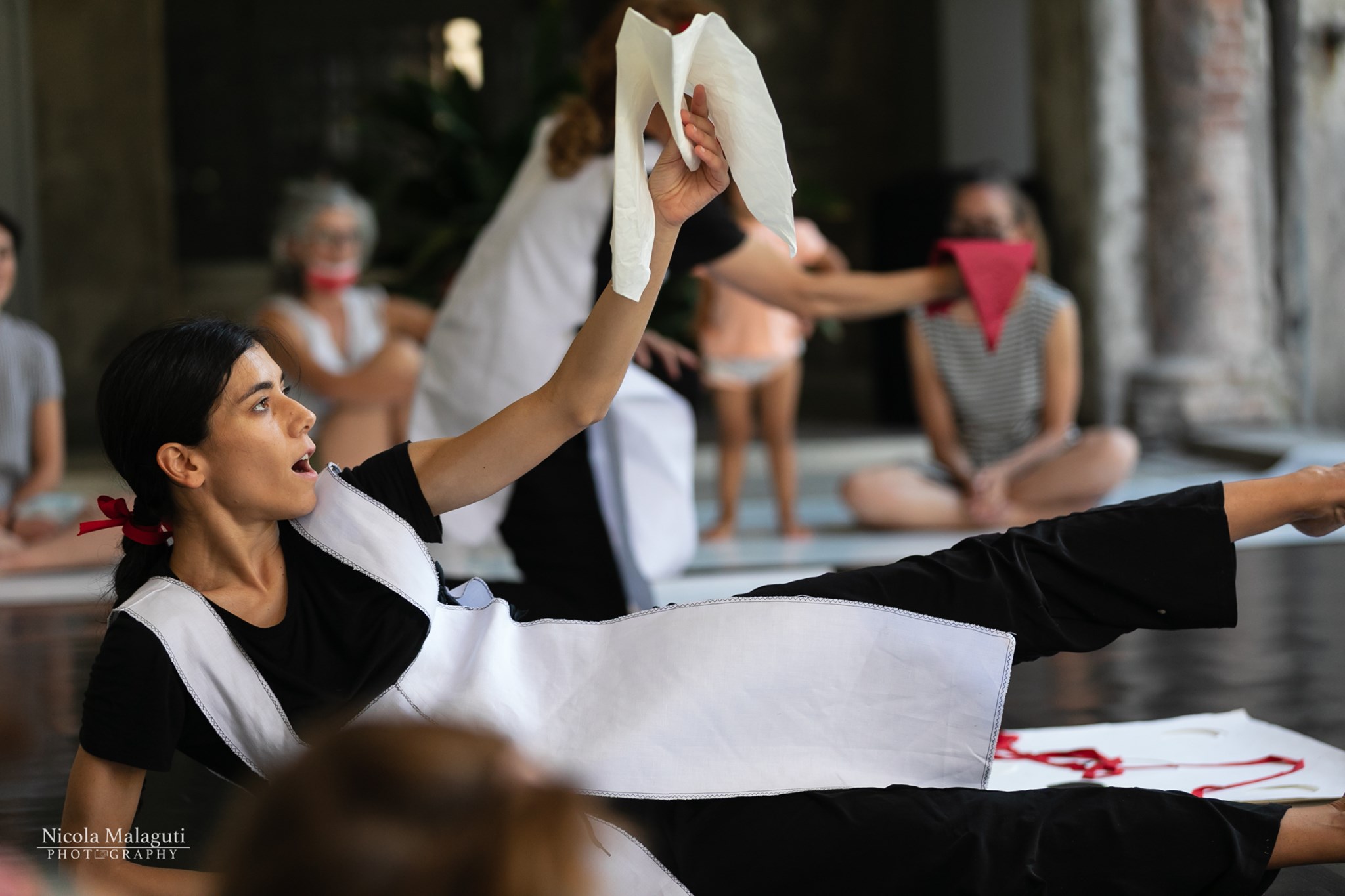
At the end of the performance, the two dancers give each child a book made with paper and threads of different kinds and shapes, which the little ones and their parents are free to discover in their own ways. The show becomes a creative tool for adults and children to explore their relationship, as it allows each to relate to the books in their preferred manner.
Corpo lib(e)ro takes its inspiration from books’ roles as a a tool of discovery and aims to make children familiar with books without words made of various materials such as paper and threads of various colours, like the famous Prelibri by Munari. The show, which is not meant to be performed in theatres, is based on the idea that words are not the only thing which can be read: a person’s body, their movement and voice, sound and pictures can all be interpreted to find meaning. This hands-on performance enriches the parent-child relationship, feeds the imagination and stimulates creativity.
“Books for toddlers are potent objects for setting up and maintaining a creative relationship between kids and grown-ups. If the adult’s role as an educator and mediator between the child and the book has been often studied, not enough attention has been placed on books’ function as a liberating instrument in the child-parent relationship. Books enable a new kind of communication between adults and children, which moves beyond the day-to-day, opens the doors of the imagination and puts parent and child on the same level.
Books for young children rekindle the wonder of childhood in us adults. They take us back to that moment in life where everything is yet to be discovered, to be invented, to be named and to be done. They allow us to be active witnesses of children’s way of being, of the minute glances and movements which we often overlook but are essential components of their cognitive, affective and physical development.
My preferred starting point when creating performances for young children is the use of materials: coarse salt, earth, feathers, water, darkness and light. There is something creative and fresh about the way young children relate to these materials. They are moved by the desire to discover and this is why I call these materials “original”, as though they were a starting point for knowledge. Books on the other hand are more complex and multi-layered. One of their basic components are the materials they are made of, be they paper, card or cloth. Then there are the shapes and pictures on the pages, the colours, sometimes the words. Another facet are the cut-out patterns, the windows and the inserts. Finally the binding gives the book and the space around it shape. Each element adds infinite possibilities for exploration. When creating this performance, I felt the need to work following a modular format: we took as our starting point the paper of the book’s pages: plain black or white squares. Then we tried to perforate the pages and to to add a red thread and some card. From this game of sensory discovery we arrived at a symbolic game and so to the birth of our paper creature. Had we discovered the spirit of the book?
Corpo lib(e)ro attempts to create and sustain the imaginative bridge between the child and the adult and tries to a be new chance to create a relationship, by stimulating the creativity and imagination of both children and grown-ups.” Anna Fascendini, director
Based on an idea by Anna Fascendini of ScarlattineTeatro/Campsirago Residenza | with Monica Serra, Marta Pala, Parwhene Frei, Giulia Vacca | Donatella Pau is the paper figure | sound Luca Maria Baldini | director Anna Fascendini | a Camprirago Residenza, Sardegna Teatro production | with the support of Autunno Danza, Festival Tuttestorie, Is Mascareddas, Teatro Instabile
Press review
“Corpo Lib(e)ro is a game which everyone can play together. On scene are Monica Serra and Giulia Vacca, both excellent dancers, and a large book, which displays all of its wonders as its pages transform. Although the two protagonists only utter sounds, the way they seem to perfectly understand each other is very enjoyable to watch. The book is made up of different kinds of pages: some are stiff card, others soft coloured tissue paper, others feature red ribbons, whiskers and cardboard circles. The protagonists’ imagination transforms these into birds, rabbits, aeroplanes, telescopes, megaphones and and many other things besides. The young spectators, sitting on the ground in their parent’s arms, look on with wonder and enjoy the moments when they can take part. The two protagonists are on the same level as the spectators, and so close you can almost touch them. They interact skilfully with the children, sharing with them the discoveries they make and the materials they transform. Their bodies and the materials the book is made of tell stories and trace temporary lines which are immediately moved, as if to say that anything can become anything else and then decide not to be at all. All the book’s pages are turned during the performance, and all of them are strewn with elements full of meaning. At last we get to the final page, which contains gifts. The package each spectator is given by the performers contains a smaller version of all the elements we have seen come to life on the stage. Slowly, each in his own time, the spectators, who have now become the protagonists, open their books and spontaneously begin creating with what is within. They look beyond the places where they sit, and they meet the eyes of the other children. They take courage and bridge the space between them over the dance floor, they exchange materials, they throw their inventions to each other, they play happily among themselves and they look deeply into each other’s eyes. Everybody has understood, each in their own way, that “together” is truly a beautiful and meaningful word. Rossella Marchi – EOLO | Teatro Ragazzi’s online magazine
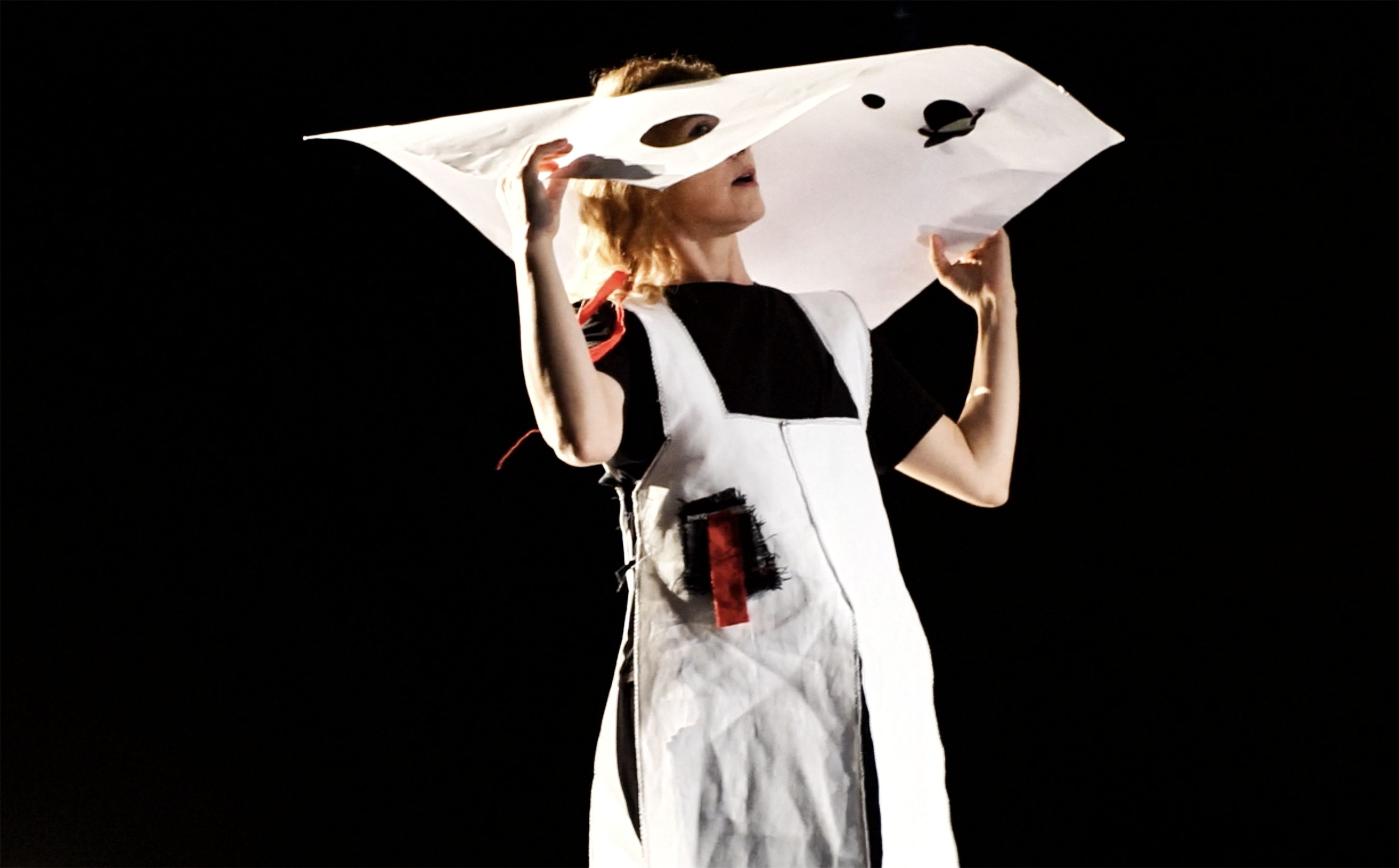
Corpo lib(e)ro is the mise en espace of a primordial kind of illustrated book for toddlers. This is not quite a picture book because the words are missing, but not a silent book either as it features sound. It could be called an action book: a living, breathing book which moves and comes to life in the scenic space of the theatre. The actresses involved appear as incarnations of the baby talk used in many children’s books, such as “Mammalingua” by Bruno Tognolini (who was by the way from Cagliari). The actresses make sounds, noises, babble, fall over and jump as they turn over the pages. In the first frames of Wim Wender’s film “Wings of Desire”, these verses by Peter Handke appear: “When the child was a child / he didn’t know he was a child”.
Most – if not all – works for young children have, on the other hand, a very clear idea of who they are written for, even if the idea of “spectator” is a deliberately artificial social construct, and as such is in a state of constant flux. In the context of Fascendini’s show, the children seem to know perfectly well that they are not children. This is why observing their reactions has been of great anthropological interest: it seemed like we were looking at creatures in the moment when they first formed thoughts, at their first attempt at understanding and deciphering reality. It was like seeing thoughts conceive of themselves. It seemed to me that the attitudes of these children could be divided into groups: the tasters, the observers, the thinkers and the listeners. […] In the show’s finale, the actresses take many small “pre-books” out of their coloured magical paper box. These collections of sheets of paper and cloth are similar to the ones the actresses used during the performance. These “pre-books” are a condensed version of the show’s story. Their chromatic palette is minimalist: black (like the room), white (like the places on the floor, where you must sit after having taken off your shoes), some red ribbons and a few yellow pages. The cover also features small crescent shapes in these colours. During a few minutes of “freedom”, the spectators are wordlessly asked to “open” their little books and to show them to the children. Even the adults, incredibly, understand what to do without instructions. This gives rise to an additional narrative thread which is left to spontaneity, play and to the relationship between parent and child. It is also a relationship between parent and pages, and pages and children: the children immerse themselves in the cloth, card or paper, hit the materials, or wear the pages on their head.
We can see in this something which Walter Benjamin had presented in his writings, collected in “Figure dell’Infanzia” (Cortina, 2012). While discussing a book on drawing in children, “Der Genius im kinde”, the German philosopher points out that the author, Hartlaub, consciously chooses to use “Genius”, not “Genie”: “the genius in the child”. The difference is that “the child doesn’t expresses himself using things, but expresses things using himself”. The children express space and the pre-book through themselves, and thus appropriate them. They feel themselves to be that sheet of paper or that red ribbon whose movements imitate theirs as they sleep in their bed or as they leap around in a field. As Benjamin says, “children’s books don’t serve to introduce their readers to the world of objects, animals and humans or to life itself. Children discover they are living in the outside world gradually and only as the world becomes familiar to them, like and inner reality adjusting to them. The inner reality of this way of seeing resides in colour and the in the dream life which colour creates in the child’s spirit”. It is natural to ask what kind of dream the child has conceived, inspired by the materials and colours, seeing how he or she “dominates and controls the illusory patina on the surface and enters the scene where the fairytale takes place between coloured cloth and multi-coloured backdrops.” It is children who are on scene in Corpo Lib(e)ro, even though not explicitly. During the performance, some of them even went as far as to get on to the stage, and became the theatrical representation of themselves. Maybe some of them perceived themselves as children for the first time? Or maybe I perceived that I had been a child myself and once had that body which I will never have again. Simone di Biasio – Doppiozero

